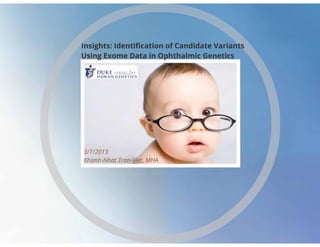Insights: Identification of Candidate Variants using Exome Data in Ophthalmic Genetics
•
0 likes•655 views
Technological advances in next generation sequencing provide clinicians and researchers with more effective methods to identify pathogenic gene mutations for heritable diseases. To date, the National Eye Institute Bank lists over 450 genes associated with eye-related disorders. Analytical processing of large datasets generated can be cumbersome for all parties involved and some issues that can cause inefficiencies include learning programming languages and reliance on inconsistent freeware. In this webcast, we demonstrate the ability to maximize Golden Helix tools to find potential pathogenic variants in rare ocular diseases.
1 of 40
Download to read offline








































